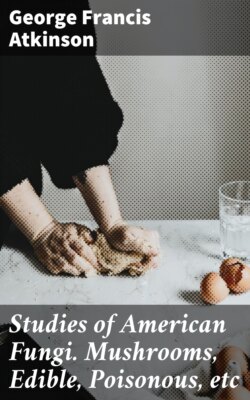Читать книгу Studies of American Fungi. Mushrooms, Edible, Poisonous, etc - George Francis Atkinson - Страница 25
На сайте Литреса книга снята с продажи.
PSATHYRELLA Fr.
ОглавлениеTable of Contents
The pileus is thin, membranaceous, striate, the margin not extending beyond the edge of the gills, and when young the margin of the pileus lies straight against the stem. The gills are black to fuliginous, of a uniform color, i.e., not spotted as in Panæolus and Anellaria. The spores are black. The plants are all fragile. Only one species is mentioned here. In appearance the species are like Psathyra of the purple-brown-spored agarics, but much thinner. Peck describes three species in the 23d Report N. Y. State Mus., p. 102 et seq. Only one species is described here.
Figure 49.—Psathyrella disseminata (natural size), caps whitish, grayish, or grayish-brown. Copyright.
Psathyrella disseminata Pers.—This is a very common and widely distributed species, appearing from late spring until late autumn. It sometimes appears in greenhouses throughout the year. The plants are 2–3 cm. high, and the caps 6–10 mm. broad. The plants are crowded in large tufts, often growing on decaying wood, but also on the ground, especially about much decayed stumps, but also in lawns and similar places, where buried roots, etc., are decaying. They resemble small specimens of a Coprinus.
The pileus is whitish or gray, or grayish brown, very thin, oval, then bell-shaped, minutely scaly, becoming smooth, prominently silicate or plicate, plaited. The gills are adnate, broad, white, gray, then black. The spores are black, oblong, 8 × 6 µ. The stem is very slender, becoming hollow, often curved. The entire plant is very fragile, and in age becomes so soft as to suggest a Coprinus in addition to the general appearance. Figure 49 is from plants collected on decaying logs at Ithaca.
